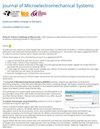An Approach to Near Zero Power Bi-Stable Driving With a Simple Pulse Signal for RF MEMS Switch
IF 2.5
3区 工程技术
Q2 ENGINEERING, ELECTRICAL & ELECTRONIC
引用次数: 0
Abstract
This paper reports a novel bi-stable structure for a radio frequency micro-electro-mechanical system (RF MEMS) switch. The structure is activated by an in-plane electrostatic actuator and adopts the Inertial Generated Timing Sequence (IGTS) method to latch, allowing the switch to turn on and off with a simple pulse signal. This design eliminates the need for a complex external control circuit and enables the switch to maintain the ON state at zero power consumption. Furthermore, the electrode shape is designed to reduce the driving voltage, thereby lowering the power consumption of the boost circuit. To test and verify the functionality of the bi-stable mechanism, a coplanar waveguide (CPW), which is separated from the actuation structure to reduce interference between the DC drive signal and the RF transmitted signal, is employed. Fabricated using a silicon-on-glass process with two lithographic masks, the RF MEMS switch achieves bi-stability with a single pulse signal of 18V for latching and 14V for unlatching. The measured insertion loss and isolation at 6 GHz are −0.28 dB and −36.68 dB, respectively. This switch exhibits low pull-in voltage, low power consumption, and simple control, holding potential for future RF systems tailored to wireless applications with an emphasis on low power consumption and system simplicity. [2024-0008]利用简单脉冲信号实现射频 MEMS 开关近零功率双稳态驱动的方法
本文报告了射频微机电系统(RF MEMS)开关的新型双稳态结构。该结构由一个平面内静电致动器激活,并采用惯性产生时序(IGTS)方法进行闩锁,使开关只需一个简单的脉冲信号即可打开和关闭。这种设计无需复杂的外部控制电路,可使开关在零功耗的情况下保持接通状态。此外,电极形状的设计可降低驱动电压,从而降低升压电路的功耗。为了测试和验证双稳态机构的功能,我们采用了共面波导(CPW),它与致动结构分离,以减少直流驱动信号和射频传输信号之间的干扰。射频 MEMS 开关采用玻璃上硅工艺和两个光刻掩模制造而成,通过 18V 的闭锁和 14V 的解锁单脉冲信号实现了双稳态。6 GHz 时的测量插入损耗和隔离度分别为 -0.28 dB 和 -36.68 dB。这种开关具有拉入电压低、功耗低和控制简单的特点,在未来为强调低功耗和系统简单性的无线应用量身定制的射频系统中大有可为。[2024-0008]
本文章由计算机程序翻译,如有差异,请以英文原文为准。
求助全文
约1分钟内获得全文
求助全文
来源期刊

Journal of Microelectromechanical Systems
工程技术-工程:电子与电气
CiteScore
6.20
自引率
7.40%
发文量
115
审稿时长
7.5 months
期刊介绍:
The topics of interest include, but are not limited to: devices ranging in size from microns to millimeters, IC-compatible fabrication techniques, other fabrication techniques, measurement of micro phenomena, theoretical results, new materials and designs, micro actuators, micro robots, micro batteries, bearings, wear, reliability, electrical interconnections, micro telemanipulation, and standards appropriate to MEMS. Application examples and application oriented devices in fluidics, optics, bio-medical engineering, etc., are also of central interest.
 求助内容:
求助内容: 应助结果提醒方式:
应助结果提醒方式:


